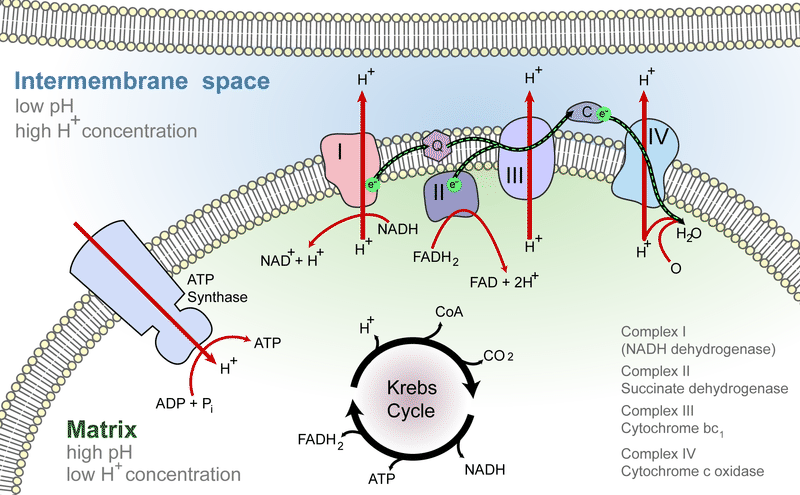6.14 电子运输链-高级
章节大纲
-
Train, truck, boat, or plane?
::火车,卡车,船,还是飞机?What do all these have in common? They are ways to transport. And they all use a lot of energy . To make ATP , energy must be "transported" - first from glucose to NADH , and then somehow passed to ATP. How is this done? With an electron transport chain , the third stage of aerobic respiration . This third stage uses energy to make energy.
::这些都是什么共同点? 它们都是运输的方式。 它们都使用大量的能量。 为了进行ATP, 能源必须“运输 ” —— 首先从葡萄糖到NADH, 然后不知怎么传递到ATP。 如何做到这一点? 使用电子运输链, 有氧呼吸的第三阶段。 这第三阶段使用能源制造能源。The Electron Transport Chain: ATP for Life in the Fast Lane
::《电子运输链:快道生命ATP》At the end of the , energy from the chemical bonds of glucose is stored in diverse energy carrier molecules: four ATPs, but also two FADH 2 and ten NADH molecules. The primary task of the last stage of , the electron transport chain , is to transfer energy from the electron carriers to even more ATP molecules, the “batteries” that power work within the .
::最终,来自葡萄糖化学链条的能量储存在不同的能量载体分子中:4个ATP,还有2个FADH2和10个NADH分子。 电子运输链这一最后阶段的首要任务是将能量从电子载体转移到更多的ATP分子中,即“电池 ” 。Pathways for making ATP in stage 3 of aerobic respiration closely resemble the electron transport chains used in . In both electron transport chains, energy carrier molecules are arranged in sequence within a membrane so that energy-carrying electrons cascade from one to another, losing a little energy in each step. In both photosynthesis and aerobic respiration, the energy lost is harnessed to pump hydrogen ions into a compartment, creating an or chemiosmotic gradient across the enclosing membrane. In both processes, the energy stored in the chemiosmotic gradient is used with ATP synthase to build ATP.
::在有氧呼吸第3阶段,使ATP在有氧呼吸第3阶段的路径与在电子运输链中使用的电子运输链相近。在两个电子运输链中,能量载体分子在膜内按顺序排列,这样能量载体电子从一个向另一个递合,每一步都会失去一点能量。在光合作用和有氧呼吸中,损失的能量被用来将氢离子泵入一个隔间,在含有膜的膜之间产生一种或化学的梯度。在这两个过程中,化学感应梯度中储存的能量与ATP合成酶一起用来制造ATP。For aerobic respiration, the electron transport chain or “respiratory chain” is embedded in the inner membrane of the ( Figure ). The FADH 2 and NADH molecules produced in and the Krebs Cycle, donate high-energy electrons to energy carrier molecules within the membrane. As they pass from one carrier to another, the energy they lose is used to pump hydrogen ions into the mitochondrial intermembrane space, creating an electrochemical gradient. Hydrogen ions flow “down” the gradient – from outer to inner compartment – through the ion channel/ ATP synthase, which transfers their energy to ATP. Note the paradox that it requires energy to create and maintain a concentration gradient of hydrogen ions that are then used by ATP synthase to create stored energy (ATP). In broad terms, it takes energy to make energy. Coupling the electron transport chain to ATP synthesis with a hydrogen ion gradient is chemiosmosis , first described by Nobel laureate Peter D. Mitchell. This process, the use of energy to phosphorylate ADP and produce ATP is also known as oxidative phosphorylation.
::为了有氧呼吸,电子运输链或“呼吸链”嵌入(Figre ) 的内膜。FADH2和NADH的分子在Krebs循环中生产,将高能电子捐赠给薄膜内的能量载体分子。当它们从一个载体传到另一个载体时,它们损失的能量被用来将氢离子泵入线交错空间,制造一个电化学梯度。氢离子“下降”梯度从外向内隔间,通过离子通道/ATP合成酶,将能量转移给ATP。注意矛盾的是,它需要能量来创造和保持氢离子的浓度梯度,而ATPynthase随后用这种能量来创造储存能源(ATP)。从广义上讲,它们需要能量来制造能源。将电子运输链与氢离子化梯度合成相连接,由诺贝尔得主Peter D. Mitchell首次描述的是染色体,从外向磷氧化剂生产能源的氧化剂也是已知的。The third stage of cellular respiration uses the energy stored during the earlier stages in NADH and FADH2 to make ATP. Electron transport chains embedded in the mitochondrial inner membrane capture high-energy electrons from the carrier molecules and use them to concentrate hydrogen ions in the intermembrane space. Hydrogen ions flow down their electrochemical gradient back into the matrix through ATP synthase channels which capture their energy to convert ADP to ATP. Notice that the process regenerated NAD+, supplying the electron acceptor molecule needed in glycolysis. After passing through the electron transport chain, low-energy electrons and low-energy hydrogen ions combine with oxygen to form . Thus, oxygen's role is to drive the entire set of ATP-producing reactions within the mitochondrion by accepting “spent” hydrogens. Oxygen is the final electron acceptor; no part of the process - from the Krebs Cycle through the electron transport chain – can happen without oxygen.
::在通过电子运输链、低能电子和低能氢离子与氧结合形成之后。 因此,氧的作用是通过接受“稀释”氢来驱动线粒体内的全部亚TP生成反应。 氧是最终的电子接收器;这一过程的一部分 — — 从克里布斯循环到电子运输链 — — 都不能在没有氧的情况下发生。The electron transport chain can convert the energy from one glucose molecule's worth of FADH 2 and NADH + H + into as many as 34 ATP. When the four ATP produced in glycolysis and the Krebs Cycle are added, the total 0f 38 ATP fits the overall equation for aerobic cellular respiration:
::电子运输链可以将一个葡萄糖分子(FADH2和NADH + H+)的能量转换为多达34ATP。 当添加以液解和Krebs循环生产的四个ATP时,总计 0f 38 ATP符合有氧细胞呼吸的总方程:Aerobic respiration is complete. If oxygen is available, cellular respiration transfers the energy from one molecule of glucose to 38 molecules of ATP, releasing carbon dioxide and water as waste. “Deliverable” food energy has become energy that can be used for work within the cell – transport within the cell, pumping ions and molecules across membranes, and building large organic molecules . Can you see how this could lead to “life in the fast lane” compared to (glycolysis alone)?
::有氧呼吸是完整的。 如果有氧,细胞呼吸将能量从一个甘蔗糖分子转移至38个ATP分子,释放二氧化碳和水作为废物。 “可实现的”食品能源已成为可以用于细胞内工作的能源 — — 细胞内运输、通过膜泵动离子和分子以及制造大型有机分子。 你能看到这如何导致“快速通道生活 ” , 与(光是气解)相比?Summary
::摘要-
The third and final stage of aerobic cellular respiration, the electron transport chain, accounts for most of the ATP.
::有氧细胞呼吸的第三阶段也是最后阶段,即电子运输链,占ATP的大部分。 -
Stage 3 transfers the energy from NADH and FADH
2
to make ATP.
::第3阶段,从NADH和FADH2将能源从NADH和FADH2转移到ATP。 -
During electron transport, energy is used to pump hydrogen ions across the mitochondrial inner membrane, from the matrix into the intermembrane space.
::在电子运输过程中,能源被用来泵出从矩阵到交错空间的微粒体内膜的氢离子。 -
A chemiosmotic gradient causes hydrogen ions to flow back across the mitochondrial membrane into the matrix, through ATP synthase, producing ATP.
::化学梯度导致氢离子通过ATP合成酶,通过生成ATP合成酶,穿过线粒体膜回流到矩阵中。 -
When ATP from glycolysis and the Krebs Cycle are added, a total of 38 ATP result from aerobic respiration of one molecule of glucose.
::当添加来自甘凝解和Krebs循环的ATP时,一个葡萄糖分子的有氧呼吸共产生38ATP。
Review
::回顾-
Summarize the overall task of Stage 3 of aerobic respiration.
::概述有氧呼吸第三阶段的总体任务。 -
Explain the principle of chemiosmosis.
::解释染色体原则。 -
Name the three stages of aerobic cellular respiration. Then write the overall equation, and identify which stage:
-
Uses each reactant.
::使用每个反应器。 -
Requires each necessary condition.
::需要每一种必要条件。 -
Produces each product.
::生产每种产品。
::命名有氧细胞呼吸的三个阶段。 然后写出整体方程, 并确定哪个阶段: 使用每个反应器。 需要每个必要的条件。 生成每个产品 。 -
Uses each reactant.
-
The third and final stage of aerobic cellular respiration, the electron transport chain, accounts for most of the ATP.


